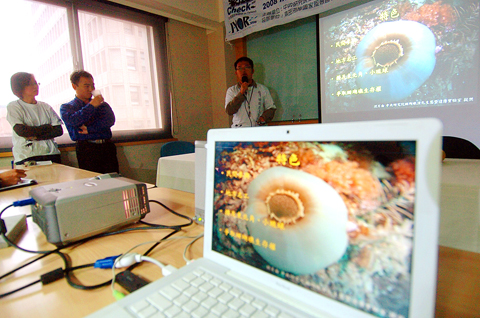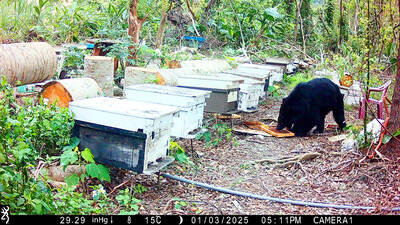A disease spreading quickly through coral reefs near Taiwan’s outlying islands poses a serious threat to the nation’s marine environment, experts and environmentalists said yesterday.
The International Year of the Reef last year called on people from 157 countries in the world to sign an online petition pledging to protect coral reefs. Each person who signed the petition pledged to behave in an environmentally responsible way — such as by using products that would not pollute the sea and eating only seafood that is caught in a sustainable manner.
Taiwan ranked fourth in the number of people who have taken the pledge, after the US, Malaysia and China.

PHOTO: LO PEI-DER, TAIPEI TIMES
“If calculated in proportion to the total population and surface area covered by coral reefs, Taiwan would actually be the champion,” said Allen Chen (陳昭倫), assistant research fellow at Academia Sinica’s Biodiversity Research Center. “This shows that Taiwanese care a lot about the preservation of coral reefs.”
Chen was one of the leaders of last year’s reef check project. Funded by Academia Sinica and other preservation organizations, 2008 Reef Check in Taiwan gathered volunteers from local Aboriginal tribes and diving groups to check the condition of coral reefs around the nation’s offshore islands.
What the volunteer divers and researchers discovered astounded them. While coral reefs were still relatively unaffected in the areas off Taitung (台東) and Penghu (澎湖), human activities were threatening their future.
“When we dived down and saw [the coral], we couldn’t believe that such a sight would exist in Taiwan. We thought, this is Taiwan’s ‘last remaining heaven,’” Chen said.
However, human activity such as development and construction, combined with over-fishing, threatens to destroy the coral reefs and endanger marine life, he said.
The researchers also found that a “black disease” was spreading quickly, covering reefs with a black disease and causing the reef coverage rate to drop in areas with more frequent human activity, such as Green Island (綠島) and Orchid Island (蘭嶼).
The discovery of a problem long suspected but seldom documented showed that coral was suffering widely in waters up to 5m deep and 300m offshore, Chen said.
“We still have to do more research to determine where the black disease comes from — is it caused by over-fishing or pollution?” Chen said.
Chen also expressed concern that in all the coastal areas they investigated, there was a serious deficiency of the types of fish that indicate the overall health of marine life. Over-fishing is caused by Taiwanese having a rich “seafood culture,” but lacking knowledge about marine preservation, he said.
Chen and other environmentalists urged the government to view coral reefs as living organisms, not rocks.
“Coral reefs are even more important than pandas because they are the largest living organism in the ocean,” Chen said, urging the government to pass laws to protect the reefs in order to ensure a rich and diverse marine ecology.
The environmental groups will be conducting another round of reef checks this year and encourage those who are interested in protecting marine life to sign up to volunteer at http://e-info.org.tw/node/40662 .
ADDITIONAL REPORTING BY AGENCIES

SHIPS, TRAINS AND AUTOMOBILES: The ministry has announced changes to varied transportation industries taking effect soon, with a number of effects for passengers Beginning next month, the post office is canceling signature upon delivery and written inquiry services for international registered small packets in accordance with the new policy of the Universal Postal Union, the Ministry of Transportation and Communications said yesterday. The new policy does not apply to packets that are to be delivered to China, the ministry said. Senders of international registered small packets would receive a NT$10 rebate on postage if the packets are sent from Jan. 1 to March 31, it added. The ministry said that three other policies are also scheduled to take effect next month. International cruise ship operators

HORROR STORIES: One victim recounted not realizing they had been stabbed and seeing people bleeding, while another recalled breaking down in tears after fleeing A man on Friday died after he tried to fight the knife-wielding suspect who went on a stabbing spree near two of Taipei’s busiest metro stations, Taipei Mayor Chiang Wan-an (蔣萬安) said. The 57-year-old man, identified by his family name, Yu (余), encountered the suspect at Exit M7 of Taipei Main Station and immediately tried to stop him, but was fatally wounded and later died, Chiang said, calling the incident “heartbreaking.” Yu’s family would receive at least NT$5 million (US$158,584) in compensation through the Taipei Rapid Transit Corp’s (TRTC) insurance coverage, he said after convening an emergency security response meeting yesterday morning. National

PLANNED: The suspect visited the crime scene before the killings, seeking information on how to access the roof, and had extensively researched a 2014 stabbing incident The suspect in a stabbing attack that killed three people and injured 11 in Taipei on Friday had planned the assault and set fires at other locations earlier in the day, law enforcement officials said yesterday. National Police Agency (NPA) Director-General Chang Jung-hsin (張榮興) said the suspect, a 27-year-old man named Chang Wen (張文), began the attacks at 3:40pm, first setting off smoke bombs on a road, damaging cars and motorbikes. Earlier, Chang Wen set fire to a rental room where he was staying on Gongyuan Road in Zhongzheng District (中正), Chang Jung-hsin said. The suspect later threw smoke grenades near two exits

The Forestry and Nature Conservation Agency yesterday launched a gift box to market honey “certified by a Formosan black bear” in appreciation of a beekeeper’s amicable interaction with a honey-thieving bear. Beekeeper Chih Ming-chen (池明鎮) in January inspected his bee farm in Hualien County’s Jhuosi Township (卓溪) and found that more than 20 beehives had been destroyed and many hives were eaten, with bear droppings and paw prints near the destroyed hives, the agency said. Chih returned to the farm to move the remaining beehives away that evening when he encountered a Formosan black bear only 20m away, the agency said. The bear